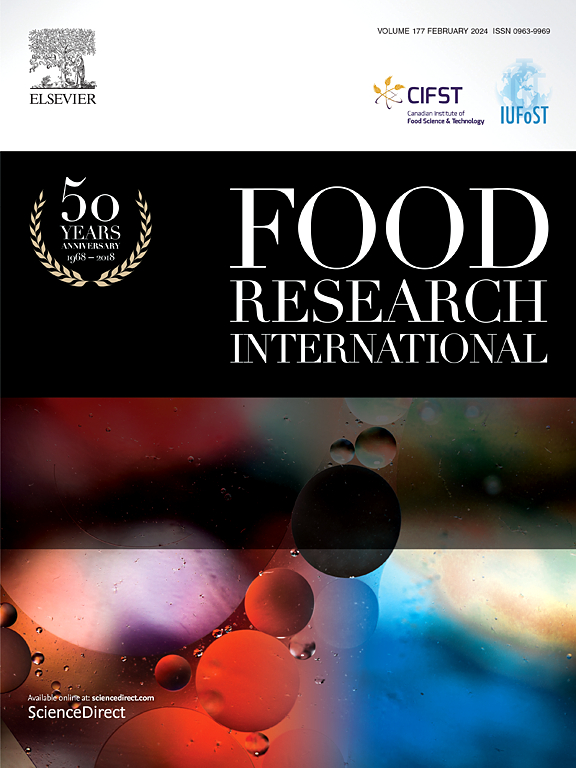非酵母菌在小曲轻味白酒工业生产中提高了产量和风味
IF 8
1区 农林科学
Q1 FOOD SCIENCE & TECHNOLOGY
引用次数: 0
摘要
研究了工业小曲淡味白酒生产中添加纤维酵母菌(Saccharomycopsis fibuligera, SF)和苦毕赤酵母(Pichia kudriavzevii, PK)对白酒微生物群落和风味物质的影响。结果表明,对照组(CK: Saccharomyces cerevisiae和Rhizopus)发酵结束时的酸度最高。在糖化阶段,SF和PK促进了根霉的生长,降低了酿酒酵母的丰度。宏基因组测序结果显示,酿酒葡萄球菌(S. cerevisiae)和helveticus乳杆菌(Lactobacillus helveticus)是发酵后期的优势菌群和优势菌群,真菌群落在细菌群落之前趋于稳定。值得注意的是,PK处理的腐培温度变化速度快于CK和SF处理,而风味物质的合成则晚于CK和SF处理。此外,SF和PK的白酒产率分别提高了4.08%和4.26%。基酒风味物质分析表明,SF和PK均能提高乙酸乙酯含量,降低乳酸乙酯含量。与此同时,β-苯乙醇、2,3-丁二醇、异戊醇和异丁醇的含量在SF中增加,而2,3-丁二醇、异戊醇和甲醇的含量在PK中最低。这些结果表明,非酿酒酵母在白酒生产中的风味和产量优化方面具有潜力。本文章由计算机程序翻译,如有差异,请以英文原文为准。

Non-Saccharomyces yeasts enhance yield and flavor in industrial xiaoqu light-flavor baijiu production
This study investigated the effects of adding Saccharomycopsis fibuligera (SF) and Pichia kudriavzevii (PK) on microbial communities and flavor substances in industrial xiaoqu light-flavor baijiu production. The result showed that the highest acidity was found in the control group (CK: Saccharomyces cerevisiae and Rhizopus) at the end of fermentation. SF and PK promoted the growth of Rhizopus while decreasing the abundance of S. cerevisiae during the saccharification stage. Metagenomic sequencing showed that S. cerevisiae and Lactobacillus helveticus were the dominant fungus and bacterium during the late stage of fermentation, and the fungal community tended to be stable before the bacterial community. Notably, the temperature change rate in zaopei (fermented grains) of PK was faster than that in CK and SF, whereas the synthesis of flavor substances was later than that in CK and SF. Moreover, the liquor yield of SF and PK increased by 4.08 % and 4.26 %, respectively. Flavor substance analysis of the base liquor demonstrated that both SF and PK elevated ethyl acetate content and decreased ethyl lactate. Meanwhile, β-phenethyl alcohol, 2,3-butanediol, isoamyl alcohol, and isobutanol contents were increased in SF, and 2,3-butanediol, isoamyl alcohol, and methanol contents were lowest in PK. These findings demonstrate the potential of non-Saccharomyces yeasts for flavor and yield optimization in baijiu production.
求助全文
通过发布文献求助,成功后即可免费获取论文全文。
去求助
来源期刊

Food Research International
工程技术-食品科技
CiteScore
12.50
自引率
7.40%
发文量
1183
审稿时长
79 days
期刊介绍:
Food Research International serves as a rapid dissemination platform for significant and impactful research in food science, technology, engineering, and nutrition. The journal focuses on publishing novel, high-quality, and high-impact review papers, original research papers, and letters to the editors across various disciplines in the science and technology of food. Additionally, it follows a policy of publishing special issues on topical and emergent subjects in food research or related areas. Selected, peer-reviewed papers from scientific meetings, workshops, and conferences on the science, technology, and engineering of foods are also featured in special issues.
 求助内容:
求助内容: 应助结果提醒方式:
应助结果提醒方式:


